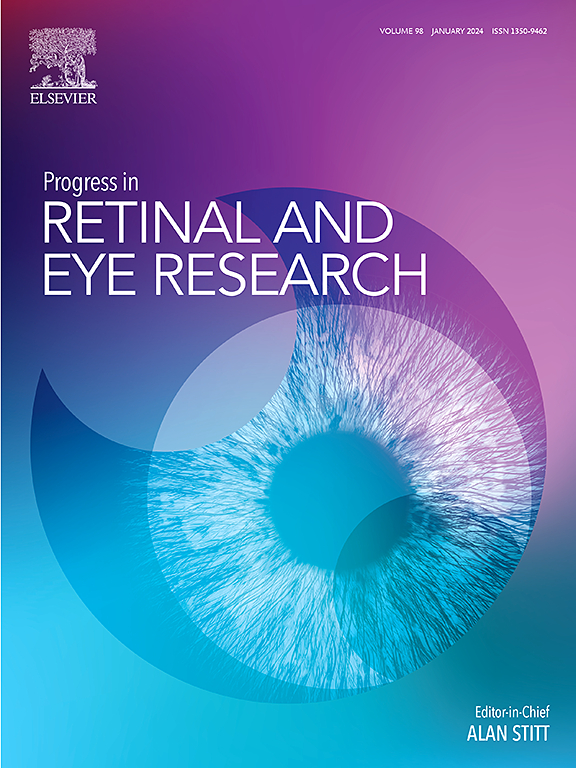解开CYP4V2: Bietti晶体角膜视网膜营养不良的临床特征、遗传见解、致病机制和治疗策略
IF 14.7
1区 医学
Q1 OPHTHALMOLOGY
引用次数: 0
摘要
遗传性视网膜营养不良症(IRDs)包括一系列具有遗传异质性和临床表型多样性的疾病表型。Bietti结晶性角膜视网膜营养不良(BCD)是一种独特的IRD亚型,其特征是视网膜中的结晶沉积。虽然在西方人群中很少见,但BCD是东亚最常见的鸟类之一,全球估计有12.4万至37.7万人受到影响。作为一种严重的IRD类型,BCD表现出加速进展,目前缺乏有效的治疗方法。BCD疾病是由CYP4V2基因的双等位基因突变引起的。CYP4V2编码序列(CDS)为1578 bp,可以有效地封装到腺相关病毒(AAV)载体中。CYP4V2作为一种羟化酶,主要表达于视网膜色素上皮(RPE)细胞中,可被aav转导,适用于替代突变蛋白功能的基因增强治疗。鉴于BCD患者群体大、视力障碍严重以及基因治疗的可行性,多个研究小组对开发BCD基因治疗产品感兴趣,有两个产品已进入III期临床试验,取得了重大进展。本文综述了BCD的临床特点、遗传学见解和致病机制,并讨论了正在进行的基因治疗临床试验,包括疗效和关注的问题。这些知识将帮助我们弥合分子研究和临床治疗之间的差距,促进从实验室到床边的转化。我们相信BCD基因治疗的进展将为其他ird的治疗提供参考。本文章由计算机程序翻译,如有差异,请以英文原文为准。
Unravelling CYP4V2: Clinical features, genetic insights, pathogenic mechanisms and therapeutic strategies in Bietti crystalline corneoretinal dystrophy
Inherited retinal dystrophies (IRDs) comprise a spectrum of disease phenotypes with genetic heterogeneity and clinical phenotypic diversity. Bietti crystalline corneoretinal dystrophy (BCD) represents a distinct IRD subtype characterized by crystalline deposits in the retina. Although rare in Western populations, BCD ranks among the most prevalent IRDs in East Asia, affecting an estimated 124,000 to 377,000 individuals worldwide. As a severe type of IRD, BCD demonstrates accelerated progression and currently lacks effective treatment. The BCD disease is caused by a biallelic mutation in the CYP4V2 gene. With a coding sequence (CDS) of 1,578 bp, CYP4V2 can be effectively encapsulated into adeno-associated virus (AAV) vectors. As a hydroxylase, CYP4V2 is mainly expressed in retinal pigment epithelial (RPE) cells, which can be transduced by AAVs and are suitable for gene augmentation therapy that replaces the function of mutant proteins. Given the large patient population, severe visual impairment, and feasibility of gene therapy, several research groups are interested in developing gene therapy products for BCD, and two products entering Phase III clinical trials have made significant progress. This review outlines the clinical features, genetic insights and pathogenic mechanisms of BCD and discusses the ongoing gene therapy clinical trials, including efficacy and concerns. This knowledge will help us bridge the gap between molecular studies and clinical treatments, facilitating translation from bench to bedside. We believe that advancements in BCD gene therapy will inform the treatment of other IRDs.
求助全文
通过发布文献求助,成功后即可免费获取论文全文。
去求助
来源期刊
CiteScore
34.10
自引率
5.10%
发文量
78
期刊介绍:
Progress in Retinal and Eye Research is a Reviews-only journal. By invitation, leading experts write on basic and clinical aspects of the eye in a style appealing to molecular biologists, neuroscientists and physiologists, as well as to vision researchers and ophthalmologists.
The journal covers all aspects of eye research, including topics pertaining to the retina and pigment epithelial layer, cornea, tears, lacrimal glands, aqueous humour, iris, ciliary body, trabeculum, lens, vitreous humour and diseases such as dry-eye, inflammation, keratoconus, corneal dystrophy, glaucoma and cataract.

 求助内容:
求助内容: 应助结果提醒方式:
应助结果提醒方式:


